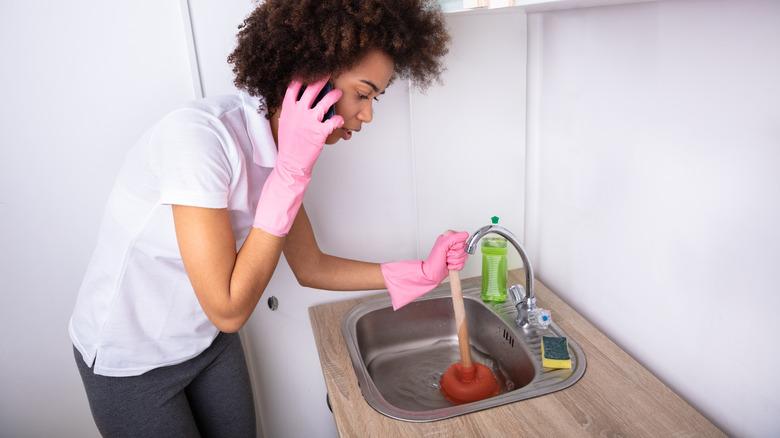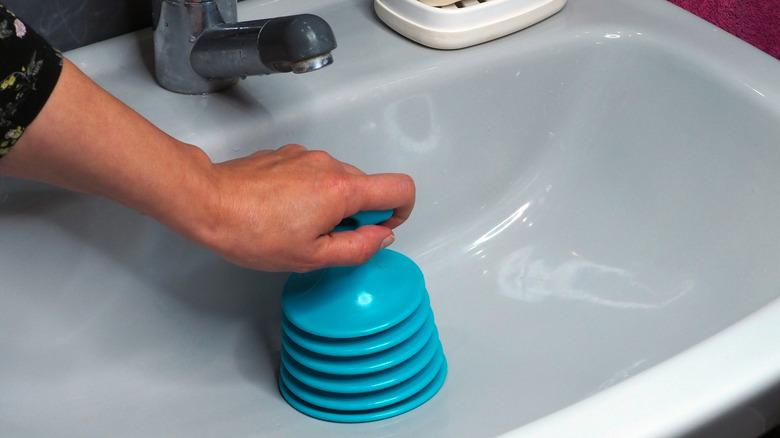The Big Difference Between Plungers (And Which Is Right For Your Job)
Plungers are one of those things you just take for granted. Unless today is one of your first few days in your first apartment, you probably have a plunger somewhere. More than likely, it's beside or behind your toilet, where the stakes are highest. But when the stakes are highest, you probably want the best tool for the job, and that might not be the standard rubber cup plunger you bought in a panic back in 2009, nor the mop-and-grocery-bag homemade toilet plunger you fashioned that one time you couldn't find it.
So, then, which plunger goes with which clog job? Hunker plunged for answers by speaking exclusively with Eddie Linares, Virtual Plumbing Expert at Frontdoor, a one‑stop app for home repair and maintenance needs. It turns out that those flat-bottomed rubber cup plungers — that is, the image that's probably in your mind when you hear the word "plunger" — are made for clearing sink drains, not toilets. "Toilet plungers have an extra rubber flange for a better seal in toilet drains," Linares said, "while sink plungers have a flat rubber cup to fit over wider drains for sinks, bathtubs, and showers."
And these aren't the only types of plungers you'll see on the hardware store shelves these days. Linares pointed out two other common categories of plunger you should be aware of. "Accordion plungers use a bellows design to create more pressure for tougher clogs," he said. "'Taze plungers use air pressure to clear serious blockages." Human inventiveness being what it is, of course, there are variations on each, like flange plungers shaped like beehives and taze plungers powered by water, or even carbon dioxide cartridges.
Here's how to use whichever plunger you have most effectively
Miles David famously used a cup-style rubber plunger as a mute for his trumpet, but for the average homeowner, the instructions for best using a plunger are going to require a bit less finesse and an entirely different focus. When Hunker spoke with Frontdoor's Eddie Linares, he gave us a rundown of how to use each of the major plunger categories. If you have a clogged tub drain or a clogged sink with a non-removable stopper or a wide drain, head over to your trumpet case and grab your good old iconic cup plunger. These also work best if you have a clogged insinkerator. "Place the sink plunger's rubber cup over the drain," Linres explained, "then push down and pull up to create suction for sink or bathtub clogs."
So far, so good. This is about what you'd expect, and both flange and accordion plungers work much the same way. "To use a toilet plunger, make sure the flange is placed properly inside the toilet drain, creating a tight seal, then plunge up and down vigorously," Linares said. "Accordion plungers work like a toilet plunger, but they create more force for tougher clogs," he added.
Linares is quick to steer homeowners away from taze plungers, whose instructions vary depending on their design. "'Taze or air plungers use air pressure to clear severe blockages," he said. "These are best suited for commercial applications versus home use."
What most people get wrong when they're using a plunger
Thinking back to that moment of panic in 2009: Did you really understand what you were trying to accomplish, or were you just flailing away at the plunger in hopes of getting everything cleared up before your date arrived and, inevitably, needed to use the loo? "The most common mistake people make is not creating a proper seal," plumbing expert Eddit Linares explained, when Hunker spoke with him exclusively. "Without a proper seal, you won't create enough suction, which makes plunging ineffective."
This need for a good seal should also prompt you to examine your plungers periodically ... and yes, probably toss the one from 2009. For one, it was probably a cup plunger you've been using on the toilet instead of an actual toilet plunger, and secondly, it's probably too old to do much good anymore. "Replace your plunger when the rubber is damaged or dried out and can no longer form a proper seal — usually every 1-2 years depending on wear and maintenance," Linares explained. And proper maintenance is a thing, too. "Make sure to clean your plunger after every use and store it in a dry ventilated area to maximize its longevity," Linares said.


